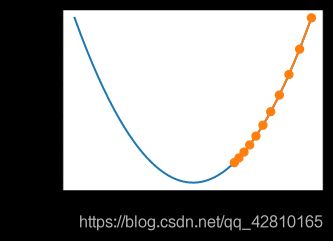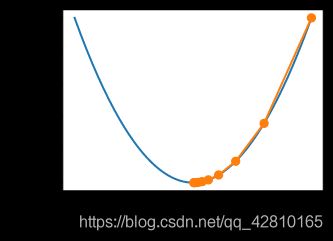DL基于Pytorch Day6 梯度下降
梯度下降
(Boyd & Vandenberghe, 2004)
%matplotlib inline
import numpy as np
import torch
import time
from torch import nn, optim
import math
import sys
sys.path.append('/home/kesci/input')
import d2lzh1981 as d2l
一维梯度下降
证明:沿梯度反方向移动自变量可以减小函数值
泰勒展开:
f ( x + ϵ ) = f ( x ) + ϵ f ′ ( x ) + O ( ϵ 2 ) f(x+ϵ)=f(x)+ϵf′(x)+O(ϵ2) f(x+ϵ)=f(x)+ϵf′(x)+O(ϵ2)
代入沿梯度方向的移动量$ ηf′(x)$:
f ( x − η f ′ ( x ) ) = f ( x ) − η f ′ 2 ( x ) + O ( η 2 f ′ 2 ( x ) ) f(x−ηf′(x))=f(x)−ηf′2(x)+O(η2f′2(x)) f(x−ηf′(x))=f(x)−ηf′2(x)+O(η2f′2(x))
f ( x − η f ′ ( x ) ) ≲ f ( x ) f(x−ηf′(x))≲f(x) f(x−ηf′(x))≲f(x)
x ← x − η f ′ ( x ) x←x−ηf′(x) x←x−ηf′(x)
e.g.
f ( x ) = x 2 f(x)=x^2 f(x)=x2
def f(x):
return x**2 # Objective function
def gradf(x):
return 2 * x # Its derivative
def gd(eta):
x = 10
results = [x]
for i in range(10):
x -= eta * gradf(x)
results.append(x)
print('epoch 10, x:', x)
return results
res = gd(0.2)
epoch 10, x: 0.06046617599999997
In [3]:
def show_trace(res):
n = max(abs(min(res)), abs(max(res)))
f_line = np.arange(-n, n, 0.01)
d2l.set_figsize((3.5, 2.5))
d2l.plt.plot(f_line, [f(x) for x in f_line],'-')
d2l.plt.plot(res, [f(x) for x in res],'-o')
d2l.plt.xlabel('x')
d2l.plt.ylabel('f(x)')
show_trace(res)
学习率
show_trace(gd(0.05))
epoch 10, x: 3.4867844009999995

show_trace(gd(1.1))
epoch 10, x: 61.917364224000096

局部极小值
e.g.
f ( x ) = x c o s c x f(x)=x cos cx f(x)=xcoscx
c = 0.15 * np.pi
def f(x):
return x * np.cos(c * x)
def gradf(x):
return np.cos(c * x) - c * x * np.sin(c * x)
show_trace(gd(2))
epoch 10, x: -1.528165927635083
多维梯度下降
def train_2d(trainer, steps=20):
x1, x2 = -5, -2
results = [(x1, x2)]
for i in range(steps):
x1, x2 = trainer(x1, x2)
results.append((x1, x2))
print('epoch %d, x1 %f, x2 %f' % (i + 1, x1, x2))
return results
def show_trace_2d(f, results):
d2l.plt.plot(*zip(*results), '-o', color='#ff7f0e')
x1, x2 = np.meshgrid(np.arange(-5.5, 1.0, 0.1), np.arange(-3.0, 1.0, 0.1))
d2l.plt.contour(x1, x2, f(x1, x2), colors='#1f77b4')
d2l.plt.xlabel('x1')
d2l.plt.ylabel('x2')
f ( x ) = x 2 1 + 2 x 2 2 f(x)=x^1_2+2x^2_2 f(x)=x21+2x22
eta = 0.1
def f_2d(x1, x2): # 目标函数
return x1 ** 2 + 2 * x2 ** 2
def gd_2d(x1, x2):
return (x1 - eta * 2 * x1, x2 - eta * 4 * x2)
show_trace_2d(f_2d, train_2d(gd_2d))
epoch 20, x1 -0.057646, x2 -0.000073
自适应方法
牛顿法
在 x+ϵ 处泰勒展开:
![]()
最小值点处满足: ∇f(x)=0, 即我们希望 ∇f(x+ϵ)=0, 对上式关于 ϵ 求导,忽略高阶无穷小,有:
![]()
c = 0.5
def f(x):
return np.cosh(c * x) # Objective
def gradf(x):
return c * np.sinh(c * x) # Derivative
def hessf(x):
return c**2 * np.cosh(c * x) # Hessian
#Hide learning rate for now
def newton(eta=1):
x = 10
results = [x]
for i in range(10):
x -= eta * gradf(x) / hessf(x)
results.append(x)
print('epoch 10, x:', x)
return results
show_trace(newton())
#epoch 10, x: 0.0
In [10]:
c = 0.15 * np.pi
def f(x):
return x * np.cos(c * x)
def gradf(x):
return np.cos(c * x) - c * x * np.sin(c * x)
def hessf(x):
return - 2 * c * np.sin(c * x) - x * c**2 * np.cos(c * x)
show_trace(newton())
#epoch 10, x: 26.83413291324767
show_trace(newton(0.5))
#epoch 10, x: 7.269860168684531
收敛性分析
预处理 (Heissan阵辅助梯度下降)
x ← x − η d i a g ( H f ) − 1 ∇ x x←x−ηdiag(Hf)^{−1}∇x x←x−ηdiag(Hf)−1∇x
随机梯度下降
随机梯度下降参数更新
对于有 n 个样本对训练数据集,设 fi(x) 是第 i 个样本的损失函数, 则目标函数为:

使用该梯度的一次更新的时间复杂度为 O(n)
随机梯度下降更新公式 O(1):
x ← x − η ∇ f i ( x ) x←x−η∇f_i(x) x←x−η∇fi(x)
且有:

e.g.
f ( x 1 , x 2 ) = x 2 1 + 2 x 2 2 f(x1,x2)=x^1_2{+}2x^2_2 f(x1,x2)=x21+2x22
def f(x1, x2):
return x1 ** 2 + 2 * x2 ** 2 # Objective
def gradf(x1, x2):
return (2 * x1, 4 * x2) # Gradient
def sgd(x1, x2): # Simulate noisy gradient
global lr # Learning rate scheduler
(g1, g2) = gradf(x1, x2) # Compute gradient
(g1, g2) = (g1 + np.random.normal(0.1), g2 + np.random.normal(0.1))
eta_t = eta * lr() # Learning rate at time t
return (x1 - eta_t * g1, x2 - eta_t * g2) # Update variables
eta = 0.1
lr = (lambda: 1) # Constant learning rate
show_trace_2d(f, train_2d(sgd, steps=50))
#epoch 50, x1 -0.027566, x2 0.137605
动态学习率
def exponential():
global ctr
ctr += 1
return math.exp(-0.1 * ctr)
ctr = 1
lr = exponential # Set up learning rate
show_trace_2d(f, train_2d(sgd, steps=1000))
epoch 1000, x1 -0.677947, x2 -0.089379
def polynomial():
global ctr
ctr += 1
return (1 + 0.1 * ctr)**(-0.5)
ctr = 1
lr = polynomial # Set up learning rate
show_trace_2d(f, train_2d(sgd, steps=50))
#epoch 50, x1 -0.095244, x2 -0.041674
小批量随机梯度下降
读取数据
def get_data_ch7(): # 本函数已保存在d2lzh_pytorch包中方便以后使用
data = np.genfromtxt('/home/kesci/input/airfoil4755/airfoil_self_noise.dat', delimiter='\t')
data = (data - data.mean(axis=0)) / data.std(axis=0) # 标准化
return torch.tensor(data[:1500, :-1], dtype=torch.float32), \
torch.tensor(data[:1500, -1], dtype=torch.float32) # 前1500个样本(每个样本5个特征)
features, labels = get_data_ch7()
features.shape
Out[16]:
torch.Size([1500, 5])
In [17]:
import pandas as pd
df = pd.read_csv('/home/kesci/input/airfoil4755/airfoil_self_noise.dat', delimiter='\t', header=None)
df.head(10)
#Out
0 1 2 3 4 5
0 800 0.0 0.3048 71.3 0.002663 126.201
1 1000 0.0 0.3048 71.3 0.002663 125.201
2 1250 0.0 0.3048 71.3 0.002663 125.951
3 1600 0.0 0.3048 71.3 0.002663 127.591
4 2000 0.0 0.3048 71.3 0.002663 127.461
5 2500 0.0 0.3048 71.3 0.002663 125.571
6 3150 0.0 0.3048 71.3 0.002663 125.201
7 4000 0.0 0.3048 71.3 0.002663 123.061
8 5000 0.0 0.3048 71.3 0.002663 121.301
9 6300 0.0 0.3048 71.3 0.002663 119.541
简洁实现
#本函数与原书不同的是这里第一个参数优化器函数而不是优化器的名字
#例如: optimizer_fn=torch.optim.SGD, optimizer_hyperparams={"lr": 0.05}
def train_pytorch_ch7(optimizer_fn, optimizer_hyperparams, features, labels,
batch_size=10, num_epochs=2):
# 初始化模型
net = nn.Sequential(
nn.Linear(features.shape[-1], 1)
)
loss = nn.MSELoss()
optimizer = optimizer_fn(net.parameters(), **optimizer_hyperparams)
def eval_loss():
return loss(net(features).view(-1), labels).item() / 2
ls = [eval_loss()]
data_iter = torch.utils.data.DataLoader(
torch.utils.data.TensorDataset(features, labels), batch_size, shuffle=True)
for _ in range(num_epochs):
start = time.time()
for batch_i, (X, y) in enumerate(data_iter):
# 除以2是为了和train_ch7保持一致, 因为squared_loss中除了2
l = loss(net(X).view(-1), y) / 2
optimizer.zero_grad()
l.backward()
optimizer.step()
if (batch_i + 1) * batch_size % 100 == 0:
ls.append(eval_loss())
# 打印结果和作图
print('loss: %f, %f sec per epoch' % (ls[-1], time.time() - start))
d2l.set_figsize()
d2l.plt.plot(np.linspace(0, num_epochs, len(ls)), ls)
d2l.plt.xlabel('epoch')
d2l.plt.ylabel('loss')
In [25]:
train_pytorch_ch7(optim.SGD, {"lr": 0.05}, features, labels, 10)
#loss: 0.243770, 0.047664 sec per epoch







